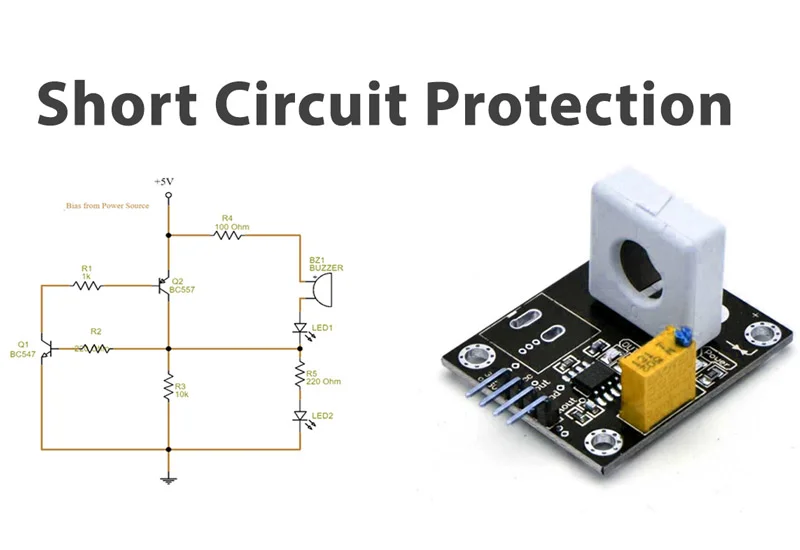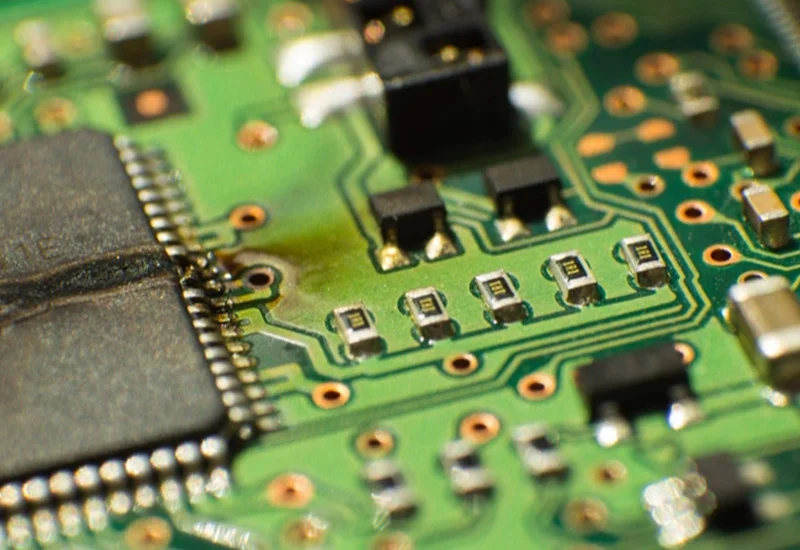Anyone working with electronic devices must understand short circuit protection. This guide covers its definition, implementation, and FAQs, ensuring effective electronics safeguarding.
What is Short Circuit Protection?

Short circuit protection focuses on preventing damage from short circuits, which occur due to unintended low-resistance connections in circuits. These mechanisms detect faults and interrupt current flow to prevent overheating and damage.
The Importance of Short Circuit Protection

Preventing Damage:
Short circuits cause sudden current surges, risking overheating, equipment damage, and fires without protection measures.
Devices like fuses and circuit breakers swiftly detect abnormal currents, preventing damage.
Ensuring Safety:
Short circuits pose electrocution and burn risks, requiring prompt detection and isolation for safer environments.
Compliance with Regulations:
Regulations mandate short circuit protection for safety and reliability, avoiding legal liabilities and reputational damage.
Reducing Downtime:
Short circuit protection minimizes equipment failure downtime, ensuring uninterrupted operations and maximizing productivity.
Enhancing Equipment Lifespan:
Protection devices extend equipment lifespan by preventing excessive current flow and reducing wear and tear.
Promoting Peace of Mind:
Reliable short-circuit protection instills confidence in electrical systems, enhancing overall well-being and environmental confidence.
Electronic Components Devices for Short Circuit Protection
Short Circuit Protection devices include fuses, circuit breakers with short-circuit trip capabilities, current limiters, and solid-state circuit protection devices. They prevent damage to circuits and equipment during short circuit faults.
The ones directly used for Short Circuit Protection are:
Circuit Breakers:
Circuit breakers specifically detect short circuits and other faults in electrical circuits. They quickly interrupt current flow to prevent damage.
Electrical, Specialty Fuses:
Primary devices for Short Circuit Protection include fuses, including specialty ones. When a short circuit occurs, the fuse melts and breaks the circuit to prevent damage.
PTC Resettable Fuses:
PTC resettable fuses provide Short Circuit Protection by increasing resistance in response to excessive current, limiting current flow and protecting the circuit.
Other devices that can be used for short circuit protection, though not exclusively, include:
Inrush Current Limiters (ICL):
While they primarily limit the initial surge of current when electrical equipment is switched on, ICLs can also help prevent short circuits by limiting current spikes.
Gas Discharge Tube Arresters (GDT):
GDTs primarily provide surge protection but can also offer some level of protection against short circuits by diverting excess voltage away.
Transient Voltage Suppressors (TVS):
TVS devices primarily protect against voltage surges and transient spikes but can also offer some level of protection against short circuits by diverting excess voltage.
While these devices may offer some level of short circuit protection, circuit breakers, and fuses are the primary devices directly designed and used for this purpose.
How Does Short Circuit Protection Work?
Current sensing:
Short circuit protection devices utilize various methods to detect abnormal current conditions. This may include magnetic sensors, detecting magnetic fields from current flow, or electronic sensors measuring voltage drops across shunt resistors.
Trip mechanism activation:
When a short circuit is detected, the protection device triggers its trip mechanism. For fuses, this means melting the internal wire to open the circuit. Circuit breakers employ electromechanical or electronic mechanisms to trip and disconnect the circuit.
Isolation of fault:
Upon circuit interruption, the protection device isolates the fault, preventing excessive current flow to downstream components, thus minimizing damage risk.
Restoration of service:
Once the fault is cleared and safety ensured, the short circuit protection device resets to restore power. For circuit breakers, this often involves manually toggling the breaker to its original position.
Benefits of Short Circuit Protection
Equipment Protection:
Short circuit protection safeguards electrical devices and equipment from damage caused by excessive current flow. By quickly interrupting the circuit, these protective measures prevent overheating and potential failure, extending the lifespan of valuable assets.
Safety Assurance:
One of the primary benefits of short circuit protection is ensuring the safety of individuals and property. By promptly detecting and mitigating faults, these protective devices reduce the risk of electrical accidents, such as fires, shocks, and burns, thereby promoting a safer environment for occupants.
Reduced Downtime:
In commercial and industrial settings, downtime due to equipment failure can result in significant financial losses. Short circuit protection helps minimize downtime by preventing damage to critical systems, allowing operations to continue uninterrupted.
Compliance with Regulations:
Many electrical codes and standards mandate the inclusion of short circuit protection in electrical installations. Compliance with these regulations not only ensures the safety and reliability of the system but also reduces the risk of legal liabilities and penalties.
Insurance Requirements:
Insurance companies often require the implementation of short-circuit protection as part of their risk assessment criteria. By investing in proper protection measures, property owners can reduce the likelihood of insurance claims and potentially lower their premiums.
Peace of Mind:
Knowing that your electrical systems are equipped with reliable short-circuit protection provides peace of mind. Whether at home, in the workplace, or in public spaces, having confidence in the safety and reliability of electrical infrastructure enhances overall well-being and confidence in the environment.
Implementing Short Circuit Protection in Your Systems
Assess Your System:
Begin by conducting a comprehensive assessment of your electrical system to identify potential areas of vulnerability to short circuits. This includes examining wiring, equipment, and circuit configurations to pinpoint potential risks.
Select Appropriate Protection Devices:
Based on your system assessment, choose the appropriate short circuit protection devices to mitigate identified risks. This may include fuses, circuit breakers, or other overcurrent protection devices, depending on the specific requirements of your system.
Consider System Requirements:
Take into account the unique requirements of your system when selecting short circuit protection devices. Factors such as voltage levels, current ratings, and fault tolerance should all be carefully considered to ensure optimal protection.
Install Protection Devices Properly:
Proper installation of short circuit protection devices is critical to their effectiveness. Follow manufacturer guidelines and industry best practices to ensure that devices are installed correctly and securely.
Regular Maintenance and Testing:
Implement a regular maintenance and testing schedule to ensure that short-circuit protection devices are functioning correctly. This includes routine inspections, testing of trip mechanisms, and replacement of faulty devices as needed.
Training and Education:
Provide training and education to personnel responsible for operating and maintaining your electrical systems. Ensure that they understand the importance of short circuit protection and know how to identify and respond to potential faults effectively.
Monitor System Performance:
Implement monitoring systems to track the performance of short circuit protection devices and detect any anomalies or issues promptly. This proactive approach allows for early intervention and prevents potential system failures.
Stay Updated on Regulations:
Keep abreast of relevant regulations and standards governing short circuit protection in your industry. Compliance with these requirements not only ensures the safety of your system but also helps avoid legal liabilities and penalties.
Short Circuit Protection in Action: Case Studies
Industrial Plant Protection:
Short circuit protection devices installed in an industrial plant swiftly detect abnormal currents, preventing equipment damage.
During routine maintenance, a technician accidentally damaged a power cable, causing a short circuit.
The protection device tripped, isolating the fault and allowing production to resume promptly.
Commercial Building Safety:
Short circuit protection in a commercial building prevents fire hazards and protects electrical infrastructure.
An electrical panel short circuit due to aging wiring insulation was swiftly isolated.
Occupants were evacuated safely, and disruptions were minimal due to effective protection measures.
Residential Electrical Safety:
Short circuit protection in a residential home safeguards against fire hazards and wiring damage.
A faulty appliance caused a kitchen outlet short circuit, swiftly detected by ground fault circuit interrupters.
The GFCI tripped, ensuring occupants’ safety and preventing further damage to the home.
FAQs
What causes a short circuit?
A short circuit can occur due to various factors, including damaged insulation, faulty wiring, equipment malfunction, or accidental contact between conductors.
How can I identify a short circuit?
Signs of a short circuit include sparks, smoke, burning odors, tripped circuit breakers, or flickering lights. If you suspect a short circuit, it’s crucial to address it promptly to prevent further damage.
Can a short circuit cause a fire?
Yes, short circuits pose a significant fire hazard. The excessive current flow generated during a short circuit can produce heat, and sparks, and potentially ignite surrounding materials, leading to a fire.
What are the consequences of a short circuit?
Short circuits can result in damage to electrical equipment, overheating of wiring, fire hazards, and the risk of electrical shocks or electrocution. Prompt detection and mitigation are essential to prevent these consequences.
How can I prevent short circuits?
To prevent short circuits, ensure proper installation of electrical wiring, use high-quality components, avoid overloading circuits, and conduct regular inspections and maintenance of electrical systems.
Do all electrical systems require short-circuit protection?
Yes, short circuit protection is essential for all electrical systems to prevent damage, ensure safety, and comply with regulatory standards. Whether in residential, commercial, or industrial settings, implementing proper protection measures is crucial for mitigating risks.
Conclusion
Short circuit protection is crucial for safeguarding electrical systems and ensuring safety. Employing devices like fuses and circuit breakers mitigates risks, promoting equipment longevity and minimizing downtime. Compliance with regulations and reduced accident risks are additional benefits.
Proper assessment, selection, and maintenance of protection devices enhance safety and reliability. Both residential and commercial settings can enjoy improved electrical infrastructure. In essence, short circuit protection measures are indispensable for a secure environment.